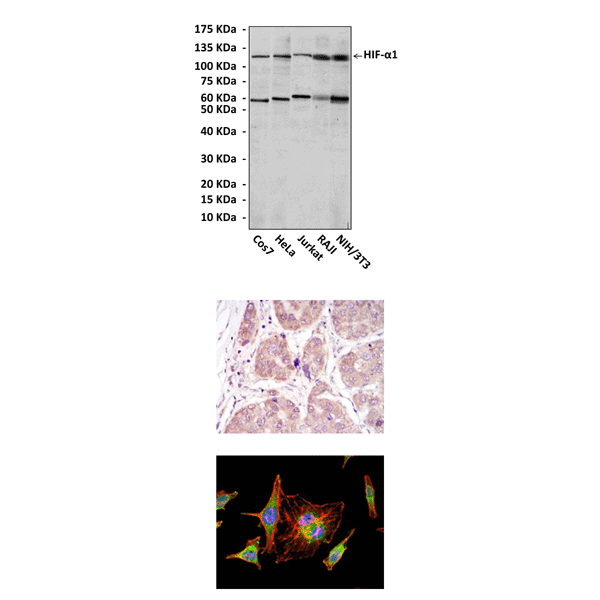Anti-HIF1α: Mouse HIF-1 alpha Antibody |
 |
BACKGROUND Hypoxia-inducible factor-1 (HIF-1) is a dimeric transcriptional complex that has been recognized primarily for its role in the maintenance of oxygen and energy homoeostasis. It consists of two basic helix-loop-helix proteins of the PAS family (PER, AHR, ARNT and SIM family): the constitutive HIF-1beta and one of either hypoxia-inducible α-subunits, HIF-1alpha or HIF-2alpha. HIF-beta subunits are non-oxygen-responsive nuclear proteins that also have other roles in transcription, for example, in the xenobiotic response. In contrast, the HIF-alpha subunits are highly inducible by hypoxia.1,2 Under normoxic conditions HIF-1alpha undergoes hydroxylation at specific prolyl residues which leads to an immediate ubiquitination and subsequent proteasomal degradation of the alpha subunit. Additionally, hydroxylation of an asparaginyl residue blocks the transcriptional activity of HIF-1 due to inhibition of its interaction with co-activators. In contrast, under hypoxic conditions, abolition of prolyl hydroxylation results in HIF-1alpha stabilization, whereas the lack of asparaginyl hydroxylation allows the transcriptional activity and the alpha/beta heterodimer binds to a core pentanucleotide sequence (RCGTG) in the hypoxia response elements (HREs) of target genes and activates expression of genes essential to cellular adaptation to low oxygen conditions. These genes include the vascular endothelial growth factor (VEGF), erythropoietin and glucose transporter-1. Additionally, the transcriptional activity may be modulated by phosphorylation or redox modification of HIF-1. In addition, HIF-1 is also by other stimulants, such as nitric oxide, various growth factors, or direct inhibitors of prolyl and asparaginyl hydroxylases. Therefore, it seems to be a crucial transcription factor elicited by a wide range of stresses such as impaired oxygenation, inflammation, energy deprivation, or intensive proliferation.3 However, the mechanisms of normoxic activation, as well as of oxygen sensing, are not yet fully known.
In cancer, activity of the HIF system is up-regulated both by microenvironmental hypoxia and by genetic changes. The clearest example of genetic activation is seen in the hereditary cancer syndrome von Hippel-Lindau (VHL) disease.4 In normal cells the product of the VHL tumour suppressor gene targets the regulatory HIF subunits (HIF-1alpha and HIF-2alpha) for oxygen-dependent proteolysis, acting as the substrate recognition component of an E3 ubiquitin ligase. In pVHL defective cells this process is blocked leading to constitutive up-regulation of HIF-1alpha subunits, activation of the HIF complex and overexpression of HIF target genes.
In cancer, activity of the HIF system is up-regulated both by microenvironmental hypoxia and by genetic changes. The clearest example of genetic activation is seen in the hereditary cancer syndrome von Hippel-Lindau (VHL) disease.4 In normal cells the product of the VHL tumour suppressor gene targets the regulatory HIF subunits (HIF-1alpha and HIF-2alpha) for oxygen-dependent proteolysis, acting as the substrate recognition component of an E3 ubiquitin ligase. In pVHL defective cells this process is blocked leading to constitutive up-regulation of HIF-1alpha subunits, activation of the HIF complex and overexpression of HIF target genes.
REFERENCES
1. Weidemann A & Johnson RS: Cell Death and Differentiation, 15: 621–627, 2008.
2. Hellwig-Bürgel T et al.: J. Interferon & Cytokine Res. 25:297-310, 2005.
3. Dery MA et al.: Int J Biochem Cell Biol.; 37:535-40, 2005.
4. Maranchie JK et al.: Cancer Cell. 1:247-55, 2002.
2. Hellwig-Bürgel T et al.: J. Interferon & Cytokine Res. 25:297-310, 2005.
3. Dery MA et al.: Int J Biochem Cell Biol.; 37:535-40, 2005.
4. Maranchie JK et al.: Cancer Cell. 1:247-55, 2002.
Products are for research use only. They are not intended for human, animal, or diagnostic applications.
Параметры
Cat.No.: | CP10379 |
Antigen: | Raised against purified recombinant fragments of human HIF-1alpha expressed in E. Coli. |
Isotype: | Mouse IgG1 |
Species & predicted species cross- reactivity ( ): | Human, Mouse, Rat |
Applications & Suggested starting dilutions:* | WB 1:1000 IP n/d IHC 1:50 - 1:200 ICC 1:50 - 1:200 FACS n/d |
Predicted Molecular Weight of protein: | 120 kDa |
Specificity/Sensitivity: | Detects HIF-1alpha proteins without cross-reactivity with other family members. |
Storage: | Store at -20°C, 4°C for frequent use. Avoid repeated freeze-thaw cycles. |
*Optimal working dilutions must be determined by end user.
Документы
Информация представлена исключительно в ознакомительных целях и ни при каких условиях не является публичной офертой








